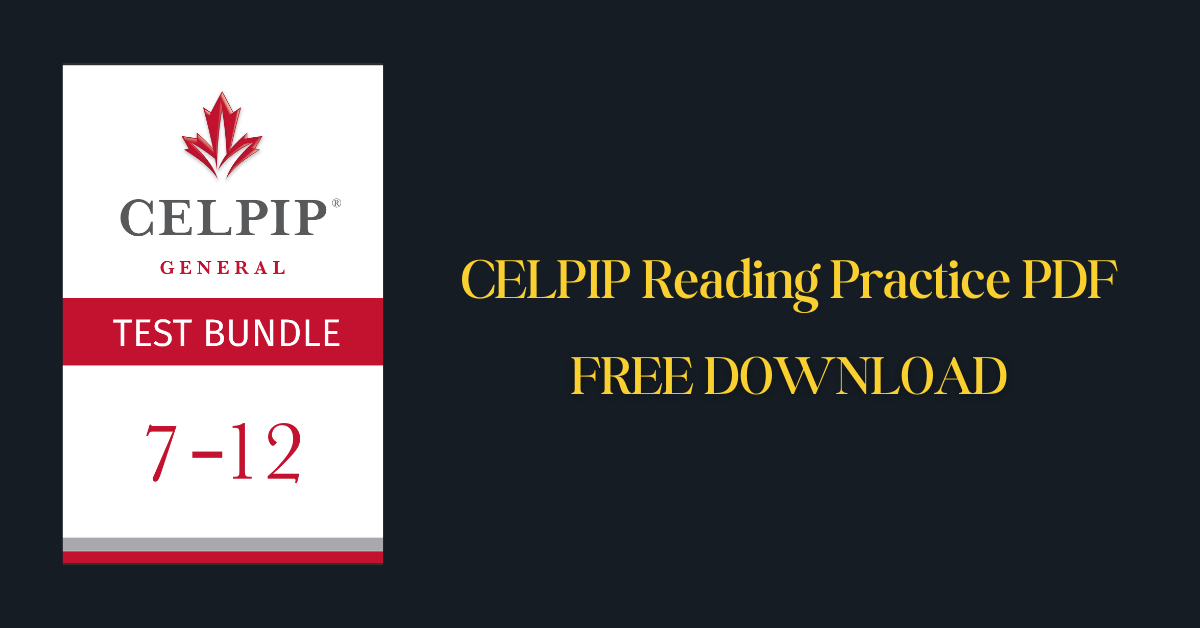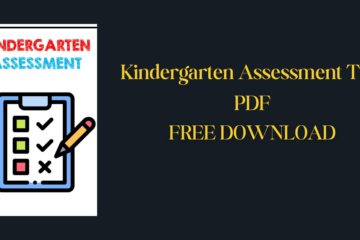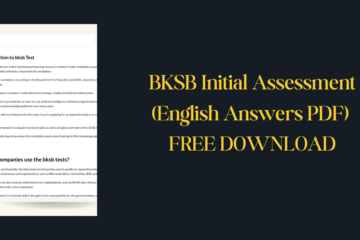The Canadian English Language Proficiency Index Program, or CELPIP, is a well-known English language evaluation tool for those who want to move to Canada for work or pursue further education. The reading portion of the CELPIP exam is one of its main components; it assesses a candidate’s aptitude for successfully understanding written English texts.
| Name of the PDF | CELPIP reading practice pdf |
| No. of pages | 11 |
| Category | |
| Language | English |
| PDF Link | Click Here |
Also Download
Transport Canada Drone Exam Study Guide PDF
Mcgraw Hill Ryerson Principles Of Mathematics 10 PDF
What is the CELPIP Test
The CELPIP (Canadian English Language Proficiency Index Program) test is a comprehensive English language assessment tool that evaluates test takers’ proficiency in listening, reading, writing, and speaking skills. It is recognized and used by various governmental bodies, professional organizations, and educational institutions in Canada for immigration and professional certification purposes.
The CELPIP test comes in two versions:
- CELPIP-General Test: This version is designed for individuals applying for permanent resident status in Canada through programs that require proof of English language skills. It assesses all four language skills.
- CELPIP-General LS Test: This version is intended for those who need to prove their listening and speaking proficiency for Canadian citizenship or other limited requirements. It assesses only listening and speaking skills.
CELPIP is known for being a fully computer-delivered test, offering test takers a unique and efficient testing experience. The use of computer delivery means that all aspects of the test—listening, reading, writing, and speaking—are conducted through a computer interface, providing consistent test administration and eliminating the variability introduced by different test administrators or speaking examiners.
The CELPIP test is managed by Paragon Testing Enterprises, a subsidiary of the University of British Columbia (UBC). It is recognized by Immigration, Refugees and Citizenship Canada (IRCC) for immigration and citizenship purposes, among other organizations.
About CELPIP Reading Test
The CELPIP Reading test is one of the four components of the CELPIP-General Test, designed to assess the reading proficiency of individuals who need to demonstrate their English language proficiency for immigration to Canada or for professional certification.
The Reading test is crafted to evaluate a wide range of reading skills, including the ability to understand correspondence, diagrams, instruction manuals, and reading passages on a variety of topics.
Structure of the CELPIP Reading Test
The CELPIP Reading test is divided into several parts, each designed to test different aspects of reading comprehension:
Part 1 – Reading Correspondence: In this section, test takers are required to read a piece of correspondence, which could be an email or a letter, and answer questions related to it. This part assesses the ability to grasp main ideas, details, and implicit meanings in personal or business correspondence.
Part 2 – Reading to Apply a Diagram: Test takers need to interpret information from diagrams, such as maps, floor plans, or charts, and answer questions based on them. This part evaluates the ability to understand and apply information presented in a visual format.
Part 3 – Reading for Information: This section involves reading informational texts, such as notices, announcements, or instructional materials, and answering questions about them. It tests the ability to scan for specific information and understand detailed factual content.
Part 4 – Reading for Viewpoints: In the final section, test takers read opinion texts or discursive essays on contemporary issues and answer questions that assess understanding of arguments, opinions, and viewpoints presented in the text.
Duration and Format
The Reading component of the CELPIP test is designed to be completed within 55-60 minutes. The test is entirely computer-delivered, with questions presented in a multiple-choice format, among other types. Test takers must read the texts and answer questions directly on a computer.
Scoring
The Reading test, like other components of the CELPIP, is scored on a scale from M (Minimal Proficiency) to 12 (Advanced Proficiency), with detailed score descriptors provided for each level. Scores reflect the test taker’s ability to understand and engage with written English in a variety of contexts relevant to everyday life, work, and community participation in Canada.
Importance of CELPIP Reading Practice
Practicing for the CELPIP Reading test is crucial for several reasons, particularly for those aiming to immigrate to Canada or fulfill professional certification requirements. Here are some key points highlighting the importance of CELPIP Reading practice:
- Improve Speed and Accuracy: Regular practice helps increase reading speed and accuracy, which are vital during the test due to its time constraints. Being able to quickly understand and analyze texts can significantly improve your test performance.
- Build Vocabulary: Exposure to diverse reading materials during practice expands your vocabulary and familiarizes you with the language patterns and terminology often found in the test.
- Understand Question Types: The CELPIP Reading test includes various types of questions (e.g., multiple-choice, matching). Practice helps you become familiar with these formats, reducing the time needed to understand what each question asks.
- Prepare for Different Text Types: The test covers a range of text types, from emails and letters to informational and opinion texts. Regular practice enables you to efficiently tackle these diverse formats.
- Enhance Time Management: Practicing under timed conditions helps develop effective time management skills, ensuring you can complete all sections within the allocated time.
- Improve Answering Techniques: You learn strategies for answering different types of questions, such as skimming for general meaning or scanning for specific information, which are crucial for the reading test.
- Increase Confidence: Familiarity with the test format and types of questions through practice can significantly boost your confidence, leading to a more relaxed and focused test-taking experience.
- Prepare Psychologically: Understanding what to expect and having experienced similar test conditions during practice sessions can reduce anxiety and improve overall performance.
- Identify Weak Areas: Regular practice helps identify areas where you may need further improvement, allowing you to focus your preparation on these specific aspects.
- Track Progress: By taking practice tests, you can monitor your progress over time, adjusting your study plan as needed to ensure continuous improvement.
- Achieve Target Scores: Through consistent practice, you can improve your reading skills, strategies, and test-taking confidence, all of which contribute to achieving or surpassing the score required for your immigration or professional certification goals.
How to Study for CELPIP Reading Test
Studying for the CELPIP Reading test efficiently involves a combination of improving your English reading skills, familiarizing yourself with the test format, and developing effective test-taking strategies. Here’s a comprehensive approach to prepare for the CELPIP Reading section:
Familiarize Yourself with the Format: Know the different sections of the CELPIP Reading test, including Reading Correspondence, Reading to Apply a Diagram, Reading for Information, and Reading for Viewpoints.
Review Official Resources: Utilize official preparation materials provided by the CELPIP, such as sample tests and the official guide, to understand the types of questions and passages you will encounter.
Broaden Your Reading: Regularly read a variety of English materials, including newspapers, academic articles, magazines, and online content. This helps improve your vocabulary and comprehension of different writing styles.
Practice Reading Techniques: Work on skimming (quickly getting the gist of a text) and scanning (looking for specific information), which are crucial skills for the test.
Learn New Words Daily: Make it a habit to learn and practice new words every day. Use a notebook or an app to track new vocabulary.
Contextual Learning: Learn words in context rather than in isolation to improve retention and understanding of how to use them in sentences.
Take Timed Practice Tests: Completing practice tests under timed conditions can help improve your time management skills and get you accustomed to the pressure of the testing environment.
Analyze Your Answers: Review your practice test answers to understand your mistakes and learn from them. Focus on why certain answers are correct or incorrect to improve your comprehension skills.
Identify Keywords: In both questions and passages, look for keywords that can guide you to the correct answers.
Learn to Eliminate Wrong Answers: Practice identifying and eliminating incorrect answers to increase your chances of selecting the right one.
Summarize Paragraphs: After reading a paragraph, try to summarize its main point in your own words. This technique can improve your ability to quickly grasp essential information.
Annotate as You Read: Make notes or highlight important parts of the text during practice sessions. While you can’t do this on the computer during the actual test, practicing this way can enhance your ability to remember key points.
Join Study Groups: Collaborating with others who are also preparing for the CELPIP can provide motivation and expose you to different study methods and perspectives.
Consider Professional Guidance: If you’re struggling with specific aspects of the reading test, a tutor who specializes in CELPIP preparation can offer personalized advice and strategies.
Set a Study Schedule: Dedicate specific times of the day to practice reading and test preparation to ensure consistent progress.
Balance Practice with Rest: While regular study is crucial, so is rest. Ensure you’re getting enough sleep and taking breaks to avoid burnout.
Set Realistic Goals: Break your study plan into manageable goals and celebrate when you achieve them to maintain motivation.
Stay Positive: Keep a positive mindset throughout your preparation. Confidence can significantly impact your test performance.
Test Day Tips
Approaching test day with a clear strategy can help reduce anxiety and improve performance. Here are essential tips to follow on the day of your CELPIP test to ensure you’re at your best:
Before the Test
- Get a Good Night’s Sleep: Rest is crucial. A well-rested mind performs significantly better than a tired one.
- Review Briefly: Instead of cramming, briefly review your notes or practice material to refresh your memory. Avoid trying to learn new information.
- Eat a Healthy Meal: Have a balanced meal before the test to ensure you have the energy needed to focus throughout the test duration.
- Prepare Your Documents: Organize all necessary identification and documents you need to bring to the test center the night before.
- Plan Your Journey: Know exactly how to get to the test center and how long it will take. Aim to arrive early to reduce stress and allow time to settle in.
At the Test Center
- Dress Comfortably: Choose comfortable clothing, considering the test center’s climate can vary.
- Bring Water and Snacks: Check what’s allowed inside the test center. Staying hydrated and having snacks during breaks can help maintain your energy levels.
- Use the Restroom Before Starting: Even if you don’t feel the need right away, it’s wise to use the restroom before the test begins to avoid discomfort during the exam.
During the Test
- Read Instructions Carefully: Take a moment to read through the instructions for each section thoroughly to avoid making careless mistakes.
- Manage Your Time Wisely: Keep an eye on the clock and allocate your time according to the sections and questions. Don’t spend too much time on one question.
- Use Elimination Strategy: If unsure about an answer, try to eliminate incorrect options first. This increases your chances of choosing the right answer.
- Stay Calm and Focused: If you find yourself getting anxious, take a few deep breaths to calm down. Focus on the question at hand, not the ones you’ve already answered or those to come.
- Review Your Answers: If time allows, go back and review your answers, especially in sections where you felt unsure.
After the Test
- Don’t Rush to Leave: Once you’ve completed the test, take a moment to ensure you haven’t missed any questions or sections. Follow the test center’s procedures for submitting your test and leaving the room.
- Reflect on the Experience: Think about what went well and what didn’t. This reflection can be invaluable if you need to retake the test or for future reference.
- Relax and Reward Yourself: After the test, do something enjoyable to relax. Acknowledge the hard work you’ve put into preparing for the test, regardless of the outcome.
Conclusion
The Canadian English Language Proficiency Index Program (CELPIP) stands as a vital tool in assessing language proficiency for those seeking opportunities in Canada. With its comprehensive approach, CELPIP not only evaluates reading skills but also listening, writing, and speaking abilities, providing a holistic measure of English proficiency.
As Canada continues to attract individuals from diverse linguistic backgrounds, CELPIP remains a cornerstone in ensuring fair and accurate assessments, facilitating integration into Canadian society, education, and workforce.
Whether for immigration purposes, academic pursuits, or professional endeavors, CELPIP serves as a reliable benchmark, fostering inclusivity and enabling individuals to realize their aspirations in the Canadian landscape of opportunities.
FAQs
What is the CELPIP reading test?
The CELPIP reading test is a crucial component of the CELPIP (Canadian English Language Proficiency Index Program) assessment, aimed at evaluating an individual’s ability to comprehend written English in various real-life contexts. It assesses how well candidates can understand and interpret different types of written materials commonly encountered in daily life, educational settings, and professional environments.
What does the CELPIP reading test consist of?
The CELPIP reading test encompasses a diverse range of textual formats, including advertisements, letters, notices, articles, and reports. Candidates are presented with passages of varying lengths and complexities, followed by questions that assess their comprehension skills. These questions may involve multiple-choice selections, filling in blanks with appropriate words or phrases, or matching information from the text to given statements or questions.
How long is the CELPIP reading test?
The CELPIP reading test typically lasts for approximately 60 minutes, during which candidates must read the provided passages and respond to the accompanying questions within the allocated time frame.
What skills are assessed in the CELPIP reading test?
The reading test evaluates a wide range of reading comprehension skills, including the ability to identify main ideas, infer meanings, recognize the author’s purpose and tone, discern organizational structures within the text, and comprehend vocabulary in context. Candidates are required to demonstrate their proficiency in understanding both explicit and implicit information presented in the passages.
How is the CELPIP reading test scored?
The CELPIP reading test is scored on a scale ranging from 0 to 12, with higher scores indicating greater proficiency in reading comprehension. The scoring is based on the number of correct responses provided by the candidate across all sections of the test.
How can I prepare for the CELPIP reading test?
Effective preparation for the reading test involves familiarizing oneself with various types of written materials, such as newspaper articles, magazine features, academic papers, and business documents. Additionally, candidates can enhance their skills by practicing with sample test questions and utilizing preparatory materials specifically designed for the CELPIP exam. Engaging in regular reading activities in English can also contribute to improving overall reading comprehension abilities.
Can I use a dictionary during the CELPIP reading test?
No, candidates are not permitted to use dictionaries or any other reference materials while taking the CELPIP reading test. The test is designed to assess candidates’ ability to comprehend written English without external aids, reflecting real-life situations where individuals must rely solely on their language proficiency.
How soon can I receive my CELPIP reading test scores?
Following the completion of the test, candidates can typically access their CELPIP scores online within approximately 8 business days. The expedited scoring process enables candidates to receive timely feedback on their performance.
What is the minimum score required for immigration or academic purposes?
The minimum CELPIP score required for immigration or academic purposes may vary depending on the specific requirements of the institution, organization, or immigration program to which individuals are applying. It is advisable for candidates to review the eligibility criteria and score requirements outlined by the relevant authorities.
How often can I take the CELPIP reading test?
There are no restrictions on the frequency with which individuals can take the CELPIP test. Candidates are free to register for the test multiple times in order to achieve their desired score or to improve their proficiency in English language skills. Each attempt provides an opportunity for candidates to gauge their progress and refine their test-taking strategies.

Niketa Mulay, a seasoned content writer and editor, has over a decade of experience. With a Master’s in Journalism, she honed her skills at The Times of India and now freelances across various industries. Passionate about reading, writing, and scuba diving, she shares expert PDF guides and tips at PDFdrivehub.com.




